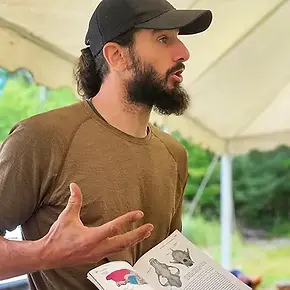
Training Workshops
New professional development workshop opportunity
Wednesday, December 18 in Chittenden County (Register Here)
Friday, January 3 in Chittenden County (Full - email to join waitlist)
Monday, January 20 in Montpelier area (Register Here)

Wildlife Track & Sign for Natural Resource Professionals
Day-long professional development workshop
Join Track & Sign Specialists Sophie Mazowita and Jonathan Shapiro for a day-long field training to develop your wildlife sign identification and interpretation skills. Whether in snow or snow-free conditions, we will share tips and techniques to detect evidence of wildlife activity and confidently interpret wildlife sign.
Field sites will be selected to maximize the diversity of tracks and sign we encounter, based on weather conditions and wildlife activity.
Program Timing: 9 a.m. to 4 p.m.
Registration Cost: Sliding Scale $75 - $115
Wednesday, December 18 & Friday, January 3: Chittenden County
These events will take place in the Burlington area or meet at the Richmond Park & Ride for a carpool to a higher-elevation location, depending on weather conditions and snow cover. The field site(s) will be decided based on scouting the week of the event and communicated to participants 1-2 days prior.
Monday, January 20: Monteplier area
This event will take place in the greater Montpelier area. The field site(s) will be decided based on scouting the week of the event and communicated to participants 1-2 days prior.
Who should attend?
-
Biologists, foresters, outdoor educators, land stewards, park rangers, environmental planners, ecologists, outreach specialists, wildlife technicians, staff of land trusts and conservation organizations (anyone currently working in or with a background in natural resources).
-
All experience levels welcome. You might be a forester or biologist with no formal training in wildlife sign ID; someone who's attended tracking walks or workshops looking for more learning opportunities; a trainee of the Keeping Track Monitoring Program wanting to refresh and broaden your skills; a certified tracker of any level; a self-taught wildlife tracker; or someone with a wildlife tracking book on your shelf who's never really dug into it.
-
Natural resource professionals looking to develop their skills in identifying and interpreting tracks and sign of a broad range of species, from mice to birds to bobcats, whether for survey and inventory purposes, education and outreach, to prepare for a CyberTracker certification, or for personal knowledge and growth.

How many species left tracks on this frozen creek in South Burlington? How were the animals moving? How can we establish a species ID of both the clear and obscure trails? What were the animals doing? What direction were they going?
Topics covered:
How and where to look: We will share a process for observing wildlife tracks and sign, plus our approaches to seeking out wildlife sign on the landscape.
Track and Trail ID: Identification of both clear and obscure prints, whether based on track morphology or an interpretation of the track pattern and context of the trail.
Gaits and Animal Locomotion: Reading track patterns and translating them into how an animal was moving. This allows us to visualize the animal that left the tracks: were they walking, trotting, bounding, hoping, loping or galloping?
Animal Sign and Marking Behavior: Feeding sign; dens, beds and lays; scat and territorial marking. As we learn to recognize these signs, the woods light up with activity in all seasons.
Recognizing Behaviors and Events: We will interpret wildlife sign as well as the story of each trail to reveal how animals are interacting with their landscape. How was the animal moving relative to their "baseline"? Were they relaxed or fleeing? Foraging, resting, or something else?

Mounds of vegetation/leaf litter found along a game trail about 20 feet away from a beaver dam.

This inch-long track was found along a muddy forest road. Is it from a front or hind foot?
Meet the Instructors:


Sophie Mazowita is a consulting naturalist and educator based in Jeffersonville, Vermont. She started her wildlife tracking journey while working as a park ranger in Algonquin Park, Ontario, then moved to Vermont to complete a Master's degree in the UVM Field Naturalist Program. Since graduating in 2013, she has studied tracking intensively with experts in New England, the Pacific Northwest, and South Africa. She initiated the Burlington VT Mammal Tracking Project in 2015 and has taught tracking workshops for dozens of groups including Green Mountain Audubon, North Branch Nature Center, the Vermont Master Naturalist Program, Champlain College, and most recently as an adjunct lecturer at UVM. Her work focuses on identifying wildlife corridors and monitoring forest connectivity at a town and regional scale, and she manages the community science program for Cold Hollow to Canada.
Jonathan Shapiro is the founder and lead instructor of the Fox Paw School, where he teaches long-term tracking, naturalist, and foraging programs. He also teaches Natural History and Field Ornithology courses as adjunct faculty at Sterling College, where he earned a B.A. in Vertebrate Natural History. He believes that a deep and accurate understanding of the more-than-human world is necessary for us to be healthy, both culturally and individually. His other interests include hunting, fishing, running, reading books by the woodstove, and making crafts.


Sophie and Jonathan are both certified as Track & Sign Specialists by Tracker Certification North America, following the international CyberTracker standard for wildlife tracker training.